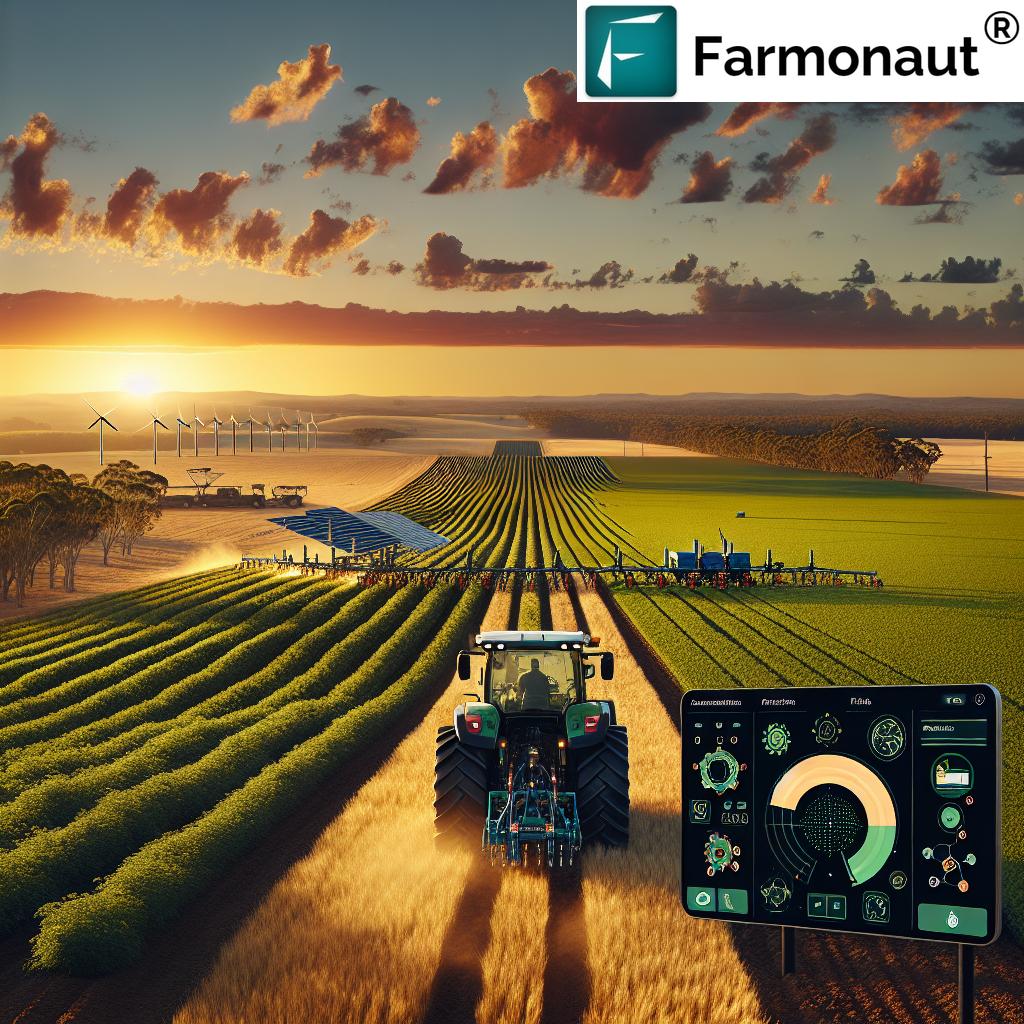Organic Farming Australia: Market Trends & Rice Farming 2025
“Australia’s organic food market is projected to reach AUD 4.2 billion by 2025, marking a 15% yearly growth rate.”
Table of Contents
- Overview of Organic Farming in Australia
- Australia Organic Farming Market Dynamics in 2025
- Advances in Sustainable Methods and Environmental Benefits
- Organic Rice Farming in Australia: Trends, Methods & Challenges
- Comparative Market Trends: Organic Rice in Australia (2023–2025)
- Farmonaut: Satellite Intelligence Empowering Organic Farming Australia
- Government Support and Certification Initiatives
- Future Outlook: Opportunities & Sustainability Impacts 2025 and Beyond
- FAQs: Organic Farming Australia & Rice Production
- Subscribe: Farmonaut’s Affordable Satellite Solutions
Overview of Organic Farming in Australia
Organic farming Australia has emerged as a vital sector within the national agriculture landscape. Driven by increasing consumer demand for organic food that is environmentally friendly and healthy, the sector continues to grow steadily. As we approach 2025, the country is set to consolidate its position as a global leader, boasting approximately 35 million hectares of certified organic land. This figure places Australia among the world’s leaders in organic agricultural production.
The organic farming Australia sector encompasses a diverse range of products, including fruits, vegetables, grains, and livestock. Notably, regions such as Queensland, Victoria, and New South Wales have witnessed remarkable growth in organic certification and output. These areas are particularly conducive to large-scale organic farming due to their extensive grazing lands, suitable climate, and developed infrastructure for sustainable cropping.
- Queensland has adapted organic farming systems for subtropical fruits and livestock grazing.
- Victoria focuses on organic vegetables, grains, pulses, and burgeoning rice production.
- New South Wales, especially via the Murray-Darling Basin, supports both diverse crop and rice cultivation employing sustainable methods.
With over 35 million hectares of certified land, Australia’s success in scaling organic farming—especially compared to many global counterparts—can be attributed to both its vast grazing area and a robust export infrastructure linking domestic production to international opportunity. This progress will only accelerate as environmental awareness and consumer consciousness continue to shape the agriculture market in 2025.
Australia Organic Farming Market Dynamics in 2025
The australia organic farming market in 2025 is marked by several significant trends and shifts, reshaping the landscape of food production and consumption. Multiple factors have catalyzed its rise:
- Expanding Consumer Base: Australian consumers increasingly value sustainably produced, chemical-free food. The health and environmental benefits of organic products have driven market preference, especially among younger, urban populations.
- Retail Transformation: Organic products are no longer niche—they are widely available in supermarkets, specialty organic stores, and online platforms. This makes organic produce far more accessible and boosts sales growth.
- Accelerating Market Growth: Retail sales of organic products have outpaced conventional counterparts, with CAGR exceeding 10% in recent years. This trend is expected to continue as markets respond to evolving consumer values.
- Export Potential: Organic production underpins a growing export industry, especially to Asia-Pacific and Europe, where demand for Australian organic grains, rice, and animal products is high.
- Government Grants and Support: Dedicated government initiatives and grants are designed to help farmers transition to organic methods, tackle certification costs, support yield stability, and promote research for further innovation.
These market dynamics signify not just the growth of organic farming Australia, but also a shift in how food is produced, consumed, and valued. Australia’s agricultural sector now integrates sustainability and environmental conservation as fundamental pillars, aligning production systems closely with climate and biodiversity goals.
Key Features of the Australia Organic Farming Market in 2025
- Diverse Product Range: Australia’s organic sector encompasses fruits, vegetables, pulses, grains, rice, and livestock, evolving to meet demand both at home and internationally.
- Certification Systems: Strict certification ensures traceability, quality, and compliance with environmental standards. Consumers trust Australia’s organic labelling and standards.
- Positive Environmental Impact: Organic practices enhance soil health, reduce chemical load on landscapes, and support biodiversity—all crucial for Australia’s climate change mitigation goals.
- Technology Integration: Satellite monitoring, AI-based advisory, and blockchain traceability platforms (such as those offered by Farmonaut) are increasingly used for sustainability and productive gains.
Advances in Sustainable Methods and Environmental Benefits
A defining feature of organic farming Australia is the commitment to sustainable agricultural practices. These techniques not only improve yield quality and consumer safety but actively contribute to the health of the environment.
- Soil Health: Organic systems nurture soil fertility through cover crops, compost, organic matter addition, and minimized tillage. This supports soil biodiversity, essential for long-term productivity.
- Reduced Synthetic Inputs: By avoiding chemical fertilizers and pesticides, organic farming lowers the risk of groundwater contamination and supports beneficial insect and pollinator populations.
- Water Management: Organic methods often enhance water retention and efficiency, crucial amid rising climate variability and water scarcity, especially in rice farming areas.
- Carbon Sequestration: Organic crop rotation, permanent pastures, and agroforestry sequester carbon in soils and vegetation, mitigating climate change.
- Biodiversity Conservation: Mixed cropping and reduced agrochemical use create habitats for native flora and fauna, sustaining ecological networks within agricultural landscapes.
- Resilient Production Systems: Sustainable methods make farming more resilient to pests, extreme weather, and market fluctuations.
In recognition of these benefits, Australia’s agricultural policies increasingly model organic systems as exemplars of responsible land management, food safety, and climate action.
“Organic rice farming in Australia grew by 28% in dedicated land area from 2020 to 2024, reflecting rising demand.”
Organic Rice Farming in Australia: Trends, Methods & Challenges
Rice farming Australia represents a unique facet of the broader organic sector. In particular, the Murray-Darling Basin of New South Wales, as well as parts of Victoria and Queensland, has developed a reputation for high-quality, sustainably farmed rice. With the global appetite for organic rice rising—fueled by both local and export demand—Australia’s rice farmers are seizing opportunities in this growing niche.
Methods: How Organic Rice Farming Works
Organic rice farming Australia places strict limits on input use and focuses on natural ecosystem functions. Key practices include:
- Soil and Water Conservation: Rotations with legumes and cover crops improve soil fertility without synthetic fertilizers.
- Natural Pest and Weed Management: Crop rotation, mechanical weeding, “duck-rice” systems, and inter-planting help manage pests without chemical pesticides. Biological control agents may also be used.
- Efficient Water Management: Floodwater recycling, precision irrigation, and scheduling matched to crop phenology maximize resource use.
- Preserving Biodiversity: Field margins are left undisturbed and wetland habitats are conserved to promote beneficial species.
Opportunities in Organic Rice Cultivation
- Niche Export Markets: Countries in South-East Asia, Japan, and the EU seek “clean and green” Australian organic rice, especially for baby food and health-conscious consumers.
- Premium Pricing: Organic rice commands higher prices, rewarding sustainable producers in a competitive market.
- Environmental Leadership: Organic rice systems serve as climate mitigation models due to reduced input use and enhanced soil sequestration.
Challenges in Organic Rice Farming
Despite these opportunities, several challenges persist:
- Water Scarcity: Rice is a water-intensive crop. Organic systems require precise water management since chemical weed and pest controls are unavailable.
- Weed and Pest Pressure: Without synthetic herbicides and pesticides, mechanical and biological methods (such as introducing natural predators or mechanical weeders) can prove laborious.
- Yield Stability: Organic yields per hectare tend to be lower than conventional rice. Research and innovation remain key to improving yields and profitability, ensuring business sustainability for farmers.
- Certification and Traceability: Achieving and maintaining organic certification is costly and administratively demanding, requiring full documentation for both local and export markets.
Given these challenges, ongoing research, government initiatives, and advanced technological solutions are essential to support Australian rice farmers in their transition and growth within the organic sector.
For rice growers seeking to implement sustainable, organic techniques, Farmonaut’s Crop Plantation & Forest Advisory tools offer AI-driven, real-time insights for land management, pest detection, and environmental monitoring. This empowers farmers to optimize yields and conserve resources while maintaining strict certification standards.
Comparative Market Trends: Organic Rice in Australia (2023–2025)
To visualize the evolving landscape of organic rice farming in Australia, let’s examine key metrics across a three-year range. This comparative market trends table captures the expansion and future projections for hectares under organic rice, yield, market value, and the share of organic within Australia’s total rice production.
| Year | Total Organic Farmland Area (hectares) | Organic Rice Yield (tons) | Market Value of Organic Rice (AUD million, estimated) | Percentage Share of Organic Rice in Total Rice Production (%) |
|---|---|---|---|---|
| 2023 | 33,000,000 | 24,000 | 36 | 6.5% |
| 2024 | 34,200,000 | 27,500 | 41 | 7.3% |
| 2025 (Estimated) | 35,000,000 | 31,000 | 49 | 8.5% |
Table: Comparative market trends and projections for organic rice farming Australia, 2023–2025
Farmonaut: Satellite Intelligence Empowering Organic Farming Australia
As precision, sustainability, and innovation become increasingly vital in organic farming Australia, advanced technologies offer unparalleled benefits. At Farmonaut, we empower farmers, producers, and agri-businesses with cutting-edge satellite-driven insights—enabling them to navigate the future of food production sustainably and efficiently.
How Farmonaut Supports Organic & Rice Farmers
- Real-Time Monitoring: Our multispectral satellite imagery tracks crop health (NDVI), soil moisture levels, and key indicators, alerting farmers to stress, disease, and health trends in their fields without on-site surveys.
- AI-Based Advisory Systems: Jeevn AI delivers tailored weather forecasts and cultivation strategies for sustainable rice farming, helping optimize yields, timing, and resource allocation—all accessible via Web, Android, and iOS apps.
- Blockchain Traceability: Our blockchain-based traceability platform ensures that every step of production, from field to store, is authentic, transparent, and secure. This is critical in upholding global organic certification and boosting buyer confidence.
- Environmental Impact Tracking: We support sustainable practices by tracking carbon footprints, biodiversity status, and emissions in real-time—critical for complying with new environmental standards in 2025 and for reporting on climate impact.
- Fleet and Resource Management: For larger operations, our fleet management solutions optimize the use of tractors, harvesters, and delivery vehicles, cutting operational costs and ensuring safety in the field.
-
API Access: Our API platform allows seamless integration of satellite and climate data into farm management systems and agritech solutions.
View Farmonaut API Developer Docs
Our subscription-based model and accessible platform mean that Australian organic farmers—regardless of scale—can leverage these tools cost-effectively. From farmers in Queensland trialing new organic rotations, to major rice operations across New South Wales seeking traceable, climate-smart agriculture, Farmonaut makes satellite intelligence practical and affordable.
Want large-scale control & precision for organic rice fields?
Farmonaut’s Large Scale Farm Management platform centralizes satellite monitoring, advisory, and record-keeping—helping producers and agronomists manage vast, certified organic landscapes efficiently.
Government Support and Certification Initiatives
Achieving the promise of sustainable, organic farming Australia relies heavily on robust certification and active government support:
- Organic Certification: Certification assures consumers that products meet “organic” standards and comply with requirements regarding soil health, biological conservation, and the absence of synthetic inputs. Australian certification bodies are recognized internationally, opening export channels.
- Financial Support and Grants: Government grants assist farmers transitioning to organic methods, upgrading infrastructure for organic compliance, or managing environmental improvement projects.
- Research and Innovation Funding: Investments in research—from pest management to novel water-use strategies for rice—bolster the sustainability and profitability of the organic agricultural sector.
- Extension and Education Programs: Farm advisory programs train Australian organic producers in market access, technology adoption, and best practices.
Future Outlook: Opportunities & Sustainability Impacts 2025 and Beyond
The outlook for organic farming Australia entering 2025 is overwhelmingly positive. Several key drivers and opportunities are set to propel this sector:
- Rising Global and Domestic Demand: As consumers become more concerned about food safety, health, and the environmental impacts of conventional agriculture, demand for certified organic products in Australia—and from global markets—will only grow.
- Premium Branding: The “Australian organic” label signifies clean, ethically produced food, enabling producers to tap into premium price segments.
- Environmental Resilience: Organic farming enables soil conservation, improved water retention, and enhanced carbon sequestration, critical to combating the impacts of climate change on Australia’s vulnerable agricultural land.
- Export Opportunities: With robust certification and traceability, Australia is well positioned to meet the needs of the Asia-Pacific region, North America, and the EU—especially for organic grains and rice.
- Technology & Innovation: From remote satellite sensing to blockchain traceability (Farmonaut traceability solutions), future-ready tools will be essential for compliance, resource management, and market access.
- Soil and Ecosystem Restoration: The organic sector leads Australia’s transition towards regenerative farming, supporting ecosystems and biodiversity better than any other mainstream food system.
However, challenges must be addressed, including moderating yield gaps versus conventional farming, managing the cost and process of organic certification, and improving distribution networks for produce. Smart technology, research, and new business models, such as Farmonaut’s pay-as-you-go subscriptions, are lowering access barriers for all users.
FAQs: Organic Farming Australia & Rice Production
What makes Australia a leader in organic farming?
Australia boasts the largest certified organic farmland area in the world (35 million hectares), robust environmental regulations, strong market growth, and a leading position in certification and export of premium organic products.
Which regions lead organic rice farming Australia?
New South Wales (especially the Murray-Darling Basin), Victoria, and Queensland are at the forefront, leveraging climate, infrastructure, and water management suited for rice cultivation without synthetic inputs.
What are the chief environmental benefits of organic rice farming?
Key benefits include reduced chemical runoff, improved soil health, carbon sequestration, biodiversity conservation, and lower overall emissions—all contributing to resilient agricultural systems.
How do farmers monitor organic fields and crops efficiently?
Integrated satellite and AI tools—such as Farmonaut’s real-time monitoring and advisory systems—allow farmers to track NDVI, soil moisture, disease, and yield potential remotely, minimizing input costs and maximizing productivity.
How is organic traceability secured?
Blockchain-based traceability solutions log every transaction and movement within the supply chain, certifying that no synthetic substances or unapproved inputs are used—critical for domestic and export compliance.
What role does government support play?
Financial grants, certification subsidies, research funding, and farmer training all play significant roles in reducing barriers, risk, and cost of transitioning to organic methods within the sector.
Subscribe: Farmonaut’s Affordable Satellite Solutions
Ready to transform your organic farm or rice operation with powerful satellite intelligence, AI, and blockchain? Check out Farmonaut’s latest pricing and sign up for a package tailored to your needs. Scale confidently, sustainably, and profitably as Australia’s organic market grows in 2025 and beyond!
Summary: Organic Farming in Australia — Trends, Challenges, and Opportunities in 2025
Organic farming Australia will continue to shape the country’s agricultural landscape through 2025, providing significant environmental, economic, and market benefits. With a large certified land area, robust certification systems, supportive government policies, and a rapidly growing consumer base, Australia is set to remain among the global leaders in sustainable, organic agriculture—especially in rice farming.
The sector still faces challenges: yield gaps, water management, and certification costs. However, solutions driven by technological innovation, research, and integrated data platforms such as Farmonaut’s satellite-based solutions are accelerating the sector’s transformation. As Australia’s organic food market climbs in value and importance, embracing sustainability, traceability, and advanced monitoring tools will be key—not only for producers but for the environment and communities countrywide.
Explore Farmonaut’s solutions for your organic farm operation and help shape the future of sustainable food and farming in Australia.













